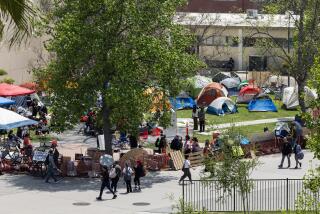LANDMARKS COUNTY HISTORICAL SITES : Sanitary Dairy Was Industry Pioneer
* HISTORY: Built in 1916 by Clifford Hardison and run by Hardison and his son Russell until 1976. It was declared a county landmark in 1989.
* LOCATION: 1680-1686 Old Telegraph Road, west Fillmore.
* HOURS: Privately owned; shown by appointment only. Contact the county Cultural Heritage Board at 654-3967.
Orange groves have replaced pasture that once supported a herd of 45 dairy cows, but the trademark silo of the Sanitary Dairy is still a landmark to drivers on Fillmore’s Old Telegraph Road. Built in 1916 by Clifford Hardison, the small family-run dairy supplied milk to Fillmore homes, schools and stores before closing in 1976.
Two of the original structures remain at 1680 Old Telegraph Road. The milking barn is essentially unchanged. The silo, which arrived by rail from Sears, Roebuck & Co. pre-cut and ready to assemble, still bears the dairy’s trademark “S-D.” It stands 40 feet tall and is topped with a wooden replica of a milk bottle. The Sanitary Dairy was deemed a historical monument in 1989 as an example of an important agricultural industry in the East Santa Clara River Valley, according to the Cultural Heritage Board records.
Current owner Russell Hardison said the Sanitary Dairy was among the first in Ventura County to use electric milking machines. A hay barn was rebuilt after a fire in 1923, and the office and creamery building were renovated in 1954 to accommodate milk processing machinery.
Clifford Hardison began his operation with a modest herd of a dozen cows. “He went around and bought up as many back-yard cows as he could so he’d be sure and have some customers,” said Russell Hardison, Clifford Hardison’s son, who took over the operation in 1946.
The first 50 customers were billed monthly for daily milk delivery. “The bill was the same even if the customer was away in Los Angeles for a few days and didn’t take any milk,” Russell Hardison said.
All milk was raw in the early days, and no more than a few hours old when Clifford Hardison delivered it in his Model-T milk truck. The dairy chilled milk with ice from its own plant, but it lacked storage, so milk was kept only as long as it took to transport it from cow to customer.
Morning chores began at 3 a.m.; milk was on the road by 6, bound for local stores and schools. The afternoon milking went to the residential route. Part-time jobs at the dairy were popular with local high school students who enjoyed riding around town on the truck’s running board. The younger Hardison worked the routes while still in elementary school. “I kind of enjoyed it--I like getting up early,” he said.
Although milking chores were usually mechanized, a pair of neighboring farm boys were pressed into service when the machines were disabled. “The electricity was kind of unreliable in those days,” Russell Hardison said.
In time, the 10 acres of pasture were planted with citrus trees as land values increased, and the herd made do with hay and grain brought in by truck. At its peak, the Sanitary Dairy served 300 customers with the milk of 45 cows.
When Russell took over the operation in 1946, he modernized. Milk was pasteurized and homogenized. Gradually, supermarkets made survival more difficult for small dairies. Hardison estimated that two-thirds of California’s smaller dairy operations quit business in the 1970s. He said his dairy was still solvent when he retired in 1976, but admitted that the work wasn’t getting any easier. “Besides,” he shrugged, “none of my kids were interested.”
More to Read
Start your day right
Sign up for Essential California for news, features and recommendations from the L.A. Times and beyond in your inbox six days a week.
You may occasionally receive promotional content from the Los Angeles Times.






